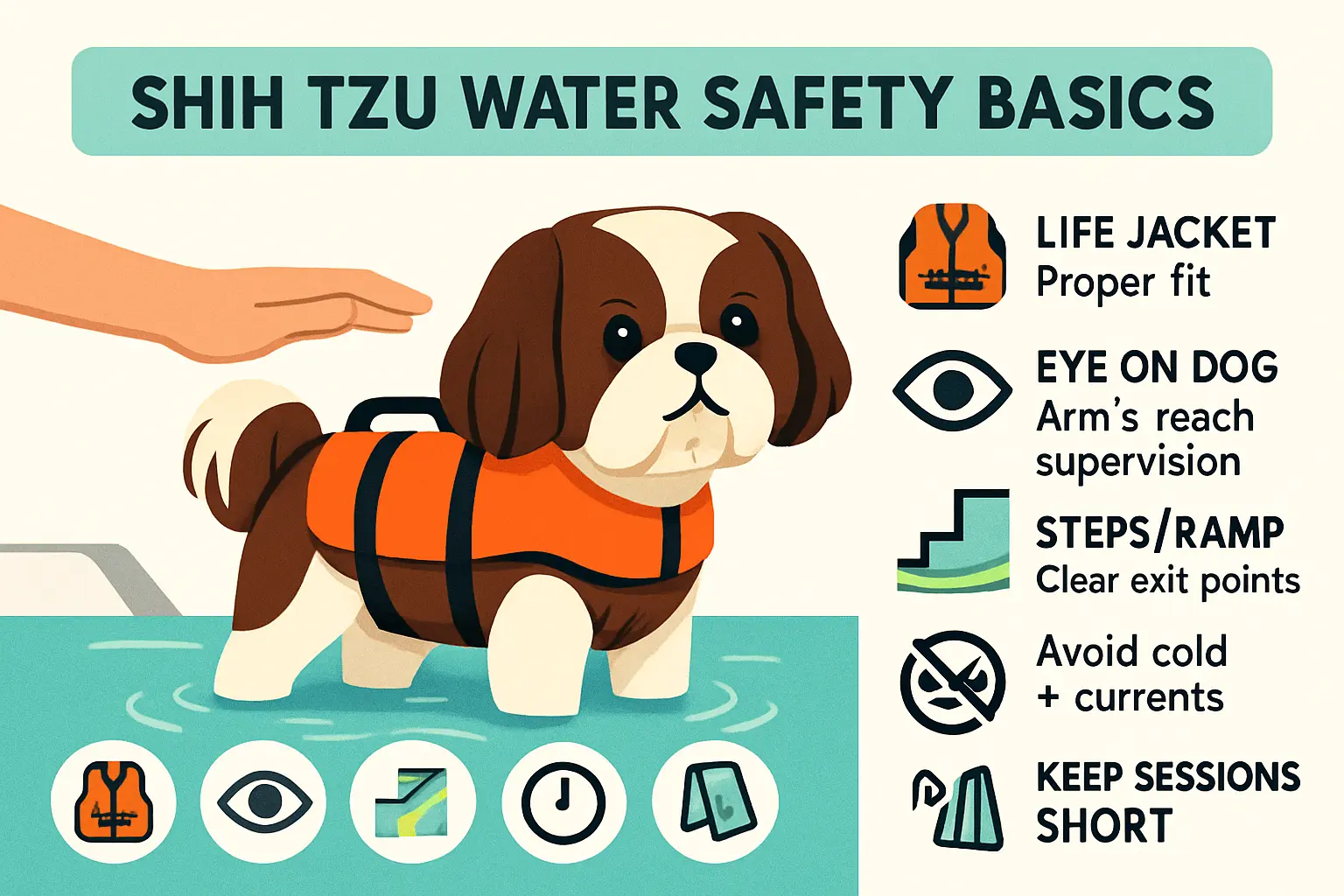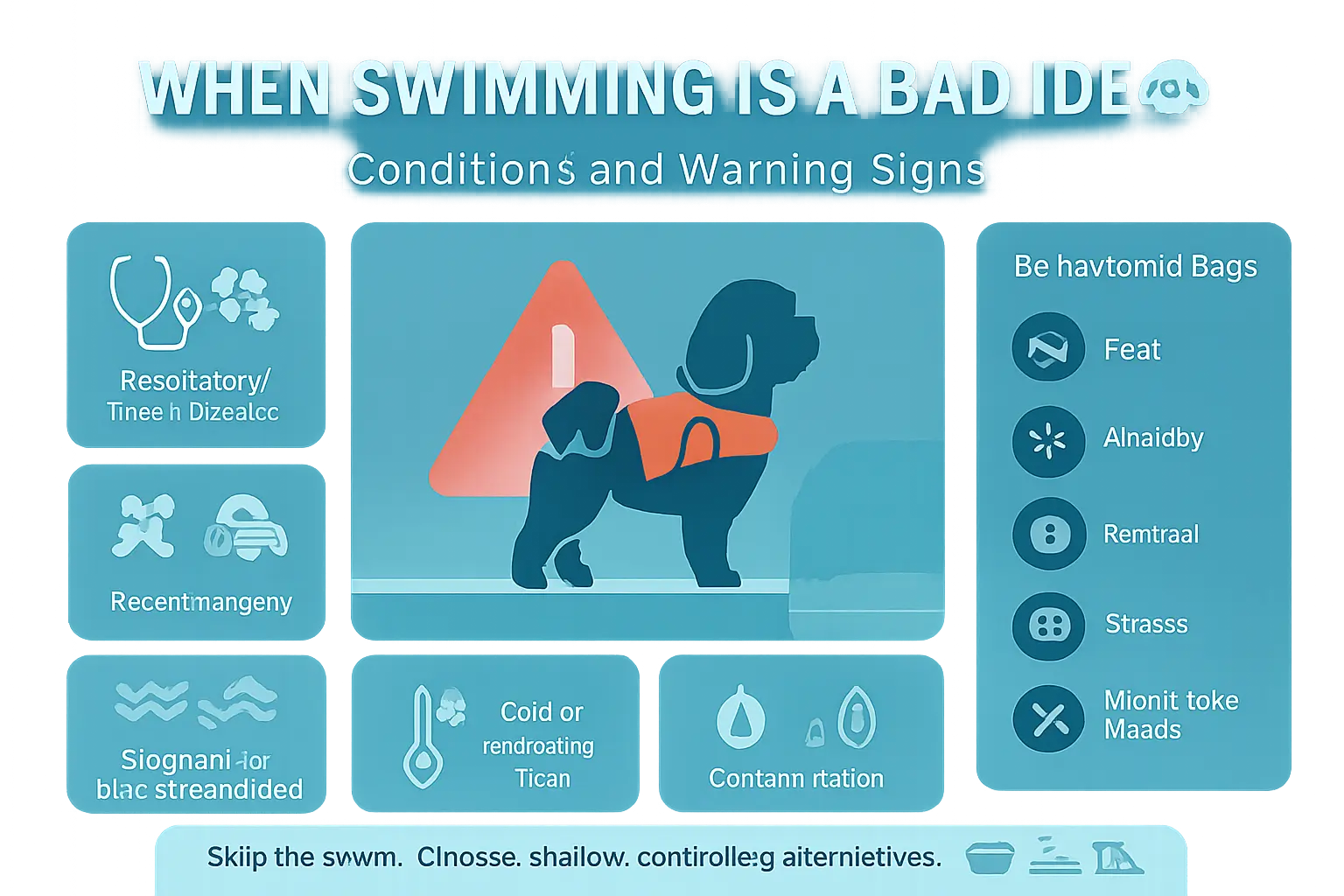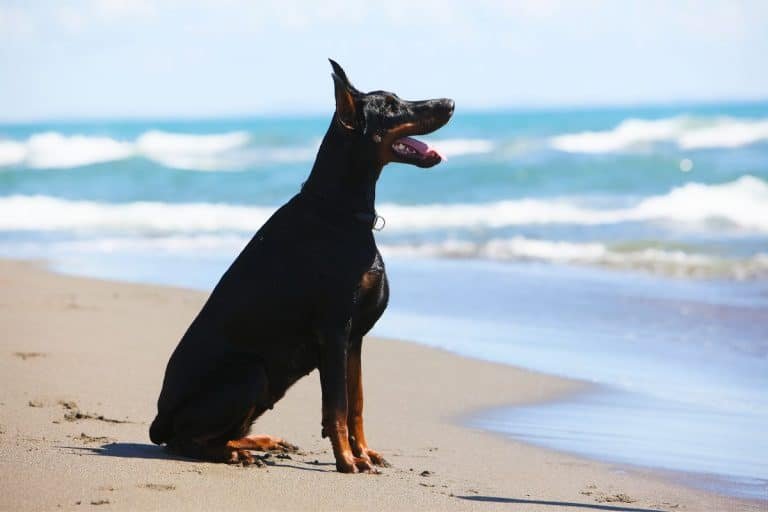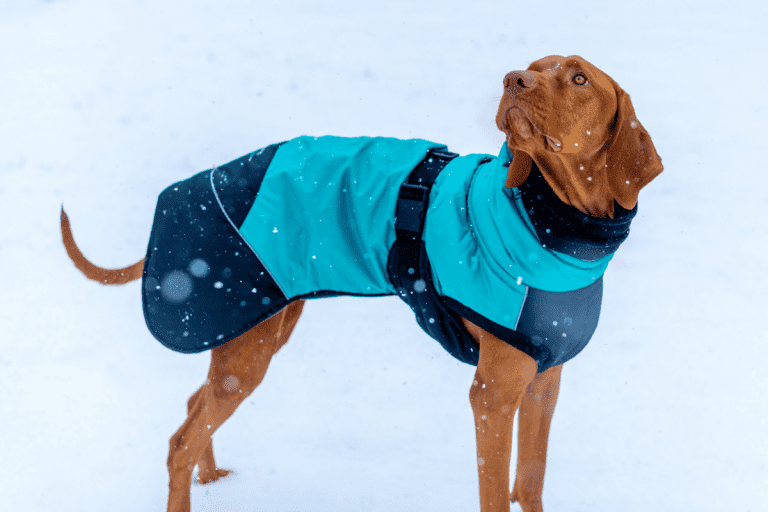Can Shih Tzus Swim? Complete Guide to Shih Tzu Swimming and Water Safety
Last Updated on August 31, 2025
Can Shih Tzus swim? Many can paddle, yet breed traits limit stamina and safety. This brachycephalic, flat-faced breed has a short muzzle, dense coat, and short legs. Those traits reduce buoyancy and airflow, making fatigue and water aspiration more likely. Supervision and a snug life jacket are essential. Calm, shallow water and brief sessions help prevent panic and cold stress.
This complete guide to Shih Tzu swimming and water safety outlines clear, practical steps. It covers gradual introductions, life-jacket fit, safe exit points, and hazard checklists. Owners also get after-care tips for ears and skin, plus red-flag signs to stop. Expect safer alternatives—kiddie pools, sprinklers, and hydrotherapy—so a Shih Tzu can enjoy water with confidence.
Can Shih Tzus Swim?
Short answer and what owners should expect
Yes — many Shih Tzus can paddle, but owners should not assume natural swimming ability. The breed has a short muzzle, heavy coat and short legs. Those traits reduce buoyancy and breathing efficiency and make sustained swimming tiring. A Shih Tzu will often instinctively dog-paddle, yet that reflex doesn’t guarantee safety or endurance.
Expect short bursts of movement rather than long swims. Puppies and older dogs tire faster. Water temperature and current matter; cold water lowers stamina and increases risk. Always use a properly fitted life jacket for supervised swims. For controlled water play, consider small shallow options such as portable, puncture-proof pools designed for dogs rather than open lakes. See 10 Refreshing Puncture-Proof Dog Pools for suitable small-pool choices.
Typical reactions — from paddling to panic
Reactions vary widely. Some Shih Tzus paddle confidently along a surface. Others freeze, scrape at the water with frantic paws, or try to climb toward shore. Common stress signs include rapid breathing, wide eyes, trembling, coughing or swallowing water. Owners should watch body position: a low or tilted head suggests struggle; constant splashing and sinking hindquarters indicate exhaustion.
Respond calmly. Slide a hand under the chest to support the dog’s weight and lead it to shallow water or the bank. Never grab the scruff; that can increase panic. Introduce water slowly, use treats and short sessions, and stop before fatigue shows. If a dog inhales water, seek veterinary advice. For safety, arrange professional swim lessons for anxious dogs and consult a vet when in doubt.
Why some Shih Tzus struggle in the water
Shih Tzus can display a wide range of reactions to water. Many struggle not because they lack curiosity, but because several physical and physiological traits work against efficient swimming. Small size and compact build reduce natural buoyancy. Short legs provide less surface area for propulsion, so the dog tires faster. A dense or long coat can soak up water and add weight. Brachycephalic skulls make breathing during strenuous activity harder, so stamina drops quickly. Behavioral factors matter too: limited early exposure or a single scary experience can create strong aversion.
Owners often compare Shih Tzus with other small companion breeds to judge realistic expectations. For breed-to-breed context, see Can Morkies Swim? which discusses how similar body types affect swimming ability. Before introducing any water activity, owners should consult a veterinarian about fitness and breathing concerns and consider a supervised, gradual approach.
Body shape and limb length impact on buoyancy
Body proportions determine how a dog floats and moves. Shih Tzus have a low-slung, compact frame with relatively short limbs. That configuration lowers the legs’ stroke length and reduces leverage against the water. A round, heavy chest shifts the center of gravity forward, which can make the rear sink and the head tip up. Those mechanics force the dog to work harder to keep the nose and mouth clear of water.
Compared with long-legged, deep-chested breeds, Shih Tzus lack the natural paddling efficiency. Owners should watch for rapid paddling with little forward motion — a sign of inefficient stroke and fatigue. Proper flotation support and short, calm sessions help build confidence and muscle without overtaxing the pup. For contrast with athletic breeds, review how larger, more streamlined dogs handle water in Can Dobermans Swim?
Brachycephalic (flat-face) breathing and stamina limits
Shih Tzus belong to the brachycephalic category. Their shortened nasal passages and compressed airways reduce airflow and increase breathing effort during exertion. Swimming adds respiratory demand because the dog must coordinate paddling with head position to breathe safely. Even brief bursts of strenuous activity can cause panting, oxygen debt, or overheating.
Because of airway sensitivity, owners must avoid long, high-intensity swims. Breaks every minute or two, shallow-water play, and constant monitoring for excessive panting or disorientation are essential. Sea-level fitness and any existing respiratory issues change risk levels, so a pre-swim vet check is prudent. For broader guidance about caring for snub-nosed breeds in travel and transport, see Airlines That Allow Snub-Nosed Dogs.
Coat type, waterlogging, and added weight
Shih Tzus often have long, dense double coats or heavy single coats. When those coats soak, they retain water and increase the dog’s effective weight. A wet coat also reduces the insulating air layer, making the dog chill faster and sapping energy. Matting exacerbates water absorption and can create uneven drag during swimming.
Owners should keep the coat trimmed around the chest and underbelly if planning water exposure. Consider a well-fitted canine life jacket to restore buoyancy and keep the head up. After-water care matters: towel dry promptly, use gentle warm air if needed, and check the ears for trapped moisture. For gear that helps manage wet coats and underbelly protection, consult product guides like Waterproof Dog Coats With Underbelly Protection.
Water-safety basics every Shih Tzu owner must follow

Shih Tzus can sometimes paddle, but their body type makes water riskier than for many breeds. Short legs, a dense coat, and a flat face reduce natural buoyancy and breathing efficiency. Owners should treat every water outing as a controlled activity, not free play.
Before any exposure, ensure the dog has a recent health check focusing on respiratory and ear issues. Limit initial sessions to calm, shallow water and watch for rapid fatigue, coughing, or labored breathing. Always provide a warm, dry place immediately after swimming. Protect ears with drying and cleaning routines to reduce infection risk; extra protection can help — see options like dog ear plugs for swimming.
Essential basics: use a properly sized flotation aid, supervise closely, identify safe exit points, and avoid cold water or strong currents. Keep sessions short and positive. If a Shih Tzu shows stress or panic, stop immediately and comfort the dog away from water.
Choosing and fitting a dog life jacket correctly
A life jacket dramatically lowers drowning risk for small dogs. Choose one rated for buoyancy and sized for the dog’s weight and chest girth. Measure the widest part of the ribcage, not just neck size. Look for a design with a secure belly strap and an adjustable chest strap that prevents the jacket from riding up.
Key features to prioritize: a sturdy grab handle, bright color or reflective panels, and neoprene or closed-cell foam that resists waterlogging. After fitting, test the jacket in waist-deep water so the dog can stand. Watch posture—paws should reach the bottom easily and the head must clear water with no neck strain.
Adjust straps after the wet test and check for chafing points. Consider layering gear for cold swims; products such as waterproof dog coats with underbelly protection help maintain body heat during short post-swim periods. Replace a jacket that becomes waterlogged, misshapen, or damaged.
Supervision, shallow zones, and safe exit points
Constant, close supervision prevents most water incidents. Place the owner or handler within arm’s reach when the Shih Tzu is near water. Assign a watcher if multiple dogs play. Never leave a small dog unattended on a dock, beach, or near an open pool.
Set up a designated shallow zone for first sessions. Inflatable paddling pools or controlled pool steps let the dog learn without deep water. Teach the dog to use ramps, steps, or a low bank as reliable exit points. Practice exiting calmly and reward the dog for using them.
For backyard play, keep a ramp or pet stairs attached to the pool edge. For lakes, scout for gradual sloping shorelines and avoid areas with boats or rip currents. Portable, shallow options reduce risk when traveling; consider one of the 10 refreshing puncture-proof dog pools for safe, contained practice.
Pool and lake hazard checklist for small breeds
Small breeds face specific environmental hazards. Use this checklist before allowing a Shih Tzu near water:
- Check for steep drop-offs and hidden currents.
- Inspect shoreline for sharp rocks, broken glass, or fishing tackle.
- Confirm clear, uncontaminated water free of blue-green algae.
- Secure pool drains and remove covers that can trap paws or fur.
- Ensure docks and boat edges have non-slip surfaces and guarded gaps.
After any swim, rinse fur to remove chlorine, algae, or sediment. Dry ears thoroughly and look for redness or discharge. Carry a basic first-aid kit and a collapsible water bowl on outings; see gear tips at essential dog travel tips and gear for road trips for portable options.
If the dog swallows large amounts of water, shows persistent coughing, or develops lethargy, seek veterinary care. Regularly review the checklist and update gear to match conditions and the dog’s comfort level.
How to introduce and teach a Shih Tzu to swim (step-by-step)
Teaching a Shih Tzu to swim works best as a sequence of small, confidence-building steps. Start by assessing health and physical limitations with a vet. Choose calm, shallow water and the right gear before any water exposure. Begin with short, positive experiences at the water’s edge. Allow the dog to sniff and explore without pressure. Gradually move to supported introductions, keeping hands under the chest and belly while the dog paddles. Progress only when the dog shows steady calm and forward movement.
Controlled environments help. A small, shallow dog pool or a calm section of a lake minimizes current and deep drop-offs. Consider portable options that are stable and puncture-resistant. Owners can review 10 refreshing puncture-proof dog pools for suitable controlled-water choices.
Always use a properly fitted life jacket until the dog swims reliably. Short, frequent sessions reinforce positive associations and build stamina. Stop at the first sign of distress and let the dog recover on dry land.
Preparing your dog and the environment
Start preparation at home. Trim long hair around the face and paws to prevent matting and water mats. Check vaccinations and overall health, especially respiratory and joint conditions. Bring a non-slip ramp or shallow entry if using a pool or dock. Ensure water temperature stays moderate; Shih Tzus tolerate cold poorly.
Choose a life jacket designed for small breeds. A handle on the jacket lets the handler support the dog quickly. Pack towels, fresh water, and a shallow first-aid kit. For a detailed checklist of travel and gear considerations, see essential dog travel tips and gear for road trips.
Environment checks: avoid strong currents, steep drop-offs, or murky water. Verify entry and exit points are safe. Remove floating toys that could encourage frantic lunges.
Progressive training steps with handling and support
Use a staged approach. Begin with the dog standing in ankle-deep water, then praise calm behavior. Next, walk alongside while supporting under the belly. Let the dog paddle while the handler provides buoyant support. Gradual depth increases build muscle and confidence.
When the dog paddles steadily with support, reduce physical assistance slowly. Keep hands near the chest and belly to catch slips. Offer a clear, short cue such as “swim” before releasing full support. Use a harness rather than a collar for lifting to avoid neck strain.
For techniques tailored to small breeds, owners may compare methods used for similar dogs. See practical tips in Can Morkies Swim, which covers stepwise introductions for small, brachycephalic mixes.
Using positive reinforcement and reading comfort cues
Positive reinforcement makes learning faster and reduces fear. Reward calm approaches to water with small treats, soft praise, or a favorite toy. Keep rewards immediate so the dog links the behavior to the reward.
Read the dog’s body language closely. Calm signals include relaxed mouth, soft eyes, and steady breathing. Signs of discomfort include rapid panting, yawning, tail tucked, frozen stance, or attempts to climb onto the handler. If the dog freezes or freezes and trembles, remove it from the water calmly and reward quiet behavior on land.
Use calming strategies from behavioral resources when anxiety appears. Techniques for reducing travel and situational anxiety can translate well to water introductions. For methods and calming aids, consult 9 natural ways to remedy your dog’s travel anxiety.
Session length, frequency, and signs to stop
Keep early sessions very short. Start with five minutes or less, then increase by two to five minutes as endurance improves. Two to three short sessions per week build conditioning without overstress. Monitor recovery between sessions.
Clear stop signals:
- Fatigue shown by frantic, inefficient paddling.
- Shivering, coughing, or labored breathing.
- Pale or bluish gums, or loss of coordination.
- Repeated attempts to climb out or dive under.
- Ear shaking or head tilting after water exposure.
Stop immediately if any of these signs appear. Dry and warm the dog, offer fresh water, and rest. Ear problems can develop after swimming, so protect and monitor the ears. Owners can review options for ear protection in dog ear plugs for swimming. If concerning symptoms persist, seek veterinary care.
After-care and health checks following water exposure

After any water session, Shih Tzu owners should perform quick, consistent after-care. Small breeds dry slower and trap moisture around skin folds. Immediate checks reduce infection risk and reveal early stress signs. Owners should focus on the coat, ears, and breathing. Record any unusual behavior during the first 24 hours. If the dog shows persistent coughing, shaking, or lethargy, seek veterinary advice without delay.
Drying coat and preventing skin problems
Start drying with an absorbent towel, pressing rather than rubbing to avoid tangles. Use a low-heat blow dryer on a distant setting if the dog tolerates it. After the coat is mostly dry, comb gently to detangle the hair and lift the undercoat. Pay special attention to facial and groin folds where moisture hides. Apply a vet-recommended moisturizer or anti-friction powder only if irritation appears. For extra protection during outings, consider a waterproof dog coats with underbelly protection to limit wet fur and reduce drying time.
Cleaning and monitoring ears to avoid infection
Shih Tzus have floppy ears that trap water. After swimming, wipe the ear flap and outer canal with a soft, dry cloth. Use a vet-approved ear cleaner to flush residual moisture if recommended. Never insert cotton swabs into the ear canal. Watch for head shaking, pawing at ears, redness, or foul odor—these indicate infection. If any of those signs appear, schedule a vet visit. Owners who plan regular water activities may also read about dog ear plugs for swimming to reduce water entry.
Recognizing delayed signs of exhaustion or respiratory issues
Signs of water-related exhaustion or respiratory distress can surface hours later. Monitor for persistent coughing, rapid or labored breathing, pale or bluish gums, weakness, or reluctance to move. Note any vomiting or fever. Shih Tzus can experience submersion-related inflammation that worsens with time. If symptoms progress or fail to improve within a few hours, contact a veterinarian immediately. To reduce risk, limit swim duration, enforce rest breaks, and keep fresh water available. For ideas on safe water options and supervision, the guide to 10 refreshing puncture-proof dog pools can help owners plan low-risk sessions.
Safe alternatives to full swimming for Shih Tzus
When full swimming proves risky for a Shih Tzu, owners can still offer safe water experiences. Short, shallow play and supervised therapeutic sessions let the dog enjoy cooling and low-impact exercise. Each option emphasizes depth control, constant supervision, and tools that support buoyancy and breathing for this brachycephalic breed.
Supervised paddling in kiddie pools and splash areas
Shallow paddling in a low-sided kiddie pool gives a controlled, gentle way to introduce water. Choose a puncture-proof pool with textured, slip-resistant flooring. Keep water depth to the dog’s chest or shallower so the paws remain on the bottom. Use a well-fitted canine life vest for extra security and never leave the dog unattended. Limit sessions to a few minutes and watch for fatigue or labored breathing. For durable options, consider products listed in 10 Refreshing Puncture-Proof Dog Pools.
Sprinklers, shallow wading, and cooling solutions
Sprinklers and shallow wading offer cooling without submersion. Aim for shaded areas and soft, non‑hot surfaces. A gentle garden sprinkler or a sprinkler mat creates splashes the dog can step through. Wet towels across the back and paw pads help regulate temperature between play sessions. Rinse salt or chlorine from fur after any public water exposure, then dry ears and skin to reduce infection risk.
Hydrotherapy and controlled pool sessions with professionals
Hydrotherapy provides therapeutic exercise under professional supervision. Certified canine hydrotherapists control water temperature, depth, and pace to protect breathing and joints. Sessions often use ramps, harnesses, or underwater treadmills tailored to breed and condition. Require a veterinary referral for medical issues. Ask a vet or certified therapist before booking, and confirm staff experience with brachycephalic dogs. These controlled sessions maximize benefit while minimizing drowning and respiratory risks.
When swimming is a bad idea — conditions and warning signs

Can Shih Tzus Swim? Complete Guide to Shih Tzu Swimming and Water Safety
Owners must recognize clear situations when water is unsafe for a Shih Tzu. Avoid swimming when the dog shows breathing difficulty, severe anxiety, visible injury, or recent veterinary restrictions. Small size and a short muzzle make strenuous swimming risky for this breed. Cold water and contaminated sites increase the chance of hypothermia and infection. Strong currents or heavy surf can overwhelm a petite swimmer.
Look for these high-risk scenarios:
- Recent surgery or stitches.
- Respiratory or heart disease.
- Puppies under the vet-recommended age for swimming.
- Stagnant water, visible algae, or sewage runoff.
When water is marginal but still considered, add protective gear and strict supervision. Use a well-fitted canine life jacket and limit sessions to shallow, calm water. Clean ears after exposure; ear protection can help—see dog ear plugs for swimming for options. Always consult a veterinarian before introducing water after illness or surgery.
Age, medical conditions, and recent surgery considerations
Puppies lack muscle strength and thermal regulation. Veterinarians usually recommend waiting until vaccines are complete and puppies can control body temperature. Senior Shih Tzus often carry arthritis, cardiac issues, or reduced stamina. These conditions raise drowning risk and stress.
Brachycephalic anatomy—short nose and compact airway—makes vigorous swimming dangerous. Dogs with respiratory disease, heart murmurs, or collapsed trachea should avoid water unless a vet approves a supervised, shallow introduction.
After surgery, water exposure can cause infection and disrupt healing. Keep any incision dry until fully healed and the vet clears swimming. Pregnant dogs need careful handling; strenuous activity or sudden immersion can stress the mother. For related guidance about travel and pregnant dogs, see can a pregnant dog travel by car?
Weather, water quality, and strong currents to avoid
Weather and water conditions directly affect safety. Cold air and water cause rapid heat loss in a small coat. Hypothermia can set in within minutes in chilly water. Hot, humid days increase exhaustion risk and heatstroke during activity.
Water quality matters more than location. Avoid any water with visible foam, scum, dead fish, or colored mats of algae. Blue-green algae (cyanobacteria) proves toxic to dogs and acts fast. Avoid standing, stagnant ponds after heavy rain; runoff can carry pathogens and chemicals. Verify local beach or lake advisories before entry.
Strong currents, rip tides, and steep drop-offs present immediate danger. Shih Tzus cannot generate the same propulsion as larger breeds. When ocean or river conditions look rough, choose a calm pool or a portable shallow option listed in 10 refreshing puncture-proof dog pools. Rinse the coat after swimming and dry ears thoroughly.
Behavioral signs that your Shih Tzu shouldn’t be pushed into water
Behavior reveals readiness. A Shih Tzu that freezes at the water’s edge, whines, tucks its tail, or bolts away shows fear. Avoid pushing or forcing entry; force increases long-term aversion and stress.
Other warning signs include frantic paddling upon brief water contact, excessive drooling, trembling, and refusing treats near water. A dog that becomes clingy or hides before water exposure likely associates water with past trauma.
Owners should use gradual desensitization if the goal is comfort. Start with shallow play, praise, and high-value treats. If refusal persists, provide alternatives like supervised splash play in a kiddie pool or controlled, land-based enrichment. For techniques to manage refusal and build cooperation, see strategies used when a dog refuses to get into a car; many behavioral principles apply.
Frequently asked questions
Can every Shih Tzu learn to swim if trained?
Many Shih Tzus can learn basic swimming skills with patient, stepwise training. Brachycephalic anatomy, short legs, or fear of water can limit progress. Start in waist-deep water, use a snug life jacket, and reward calm paddling. Some dogs never enjoy water; respect their limits.
How long can a Shih Tzu safely be in the water?
Limit sessions based on age, fitness, and temperature. Puppies and seniors should swim 5–10 minutes per session. Healthy adults can often manage 10–20 minutes with breaks. Cold water shortens safe time. Always dry the dog thoroughly after swimming to prevent hypothermia and ear problems.
What type of life jacket works best for a Shih Tzu?
Choose a small, well-fitted vest with a high collar and a sturdy back handle. Look for adjustable straps under the chest and belly and buoyant foam panels around the ribcage and chest. A front flotation panel helps keep the head up for struggling beginners. Test fit on land to confirm freedom of movement.
Will swimming help my Shih Tzu lose weight or build fitness?
Yes. Swimming provides low-impact cardiovascular exercise that burns calories and builds muscle. It benefits dogs with joint issues or excess weight when paired with calorie control. Track session length and intensity, and consult a veterinarian before starting a new exercise plan.
How to respond if my Shih Tzu shows signs of drowning or distress?
Watch for frantic paddling, submerged snout, weak strokes, or difficulty breathing. Reach the dog with a buoyant object or use a back-handle on the life jacket. Pull the dog to shore, keep the airway clear, dry and warm the dog, and seek veterinary care if coughing or lethargy follows. For ear-care prevention after a swim, owners can review options like dog ear plugs for swimming.
Summary
Can Shih Tzus Swim? Complete Guide to Shih Tzu Swimming and Water Safety explains that while many Shih Tzus can paddle, breed traits—short legs, dense coats, and brachycephalic airways—limit buoyancy, stamina, and breathing efficiency. Swimming should be treated as a controlled activity with constant supervision, a properly fitted life jacket, and short, shallow sessions.
This guide outlines how to introduce water step by step, fit and test a life jacket, choose safe environments, and spot distress early. It also covers after-care for coat and ears, health cautions, and safe alternatives to full swimming such as kiddie pools, sprinklers, and professional hydrotherapy.
Key Takeaways
- Health first: Get a vet check for brachycephalic risks and ear health before any water activity.
- Always use a life jacket: Fit by chest girth, choose a sturdy handle and reflective details, and wet-test in shallow water.
- Start shallow and go slow: Support under the chest/belly, keep sessions brief, teach clear exit points, and use positive reinforcement.
- Control conditions: Avoid cold water, strong currents, steep drop-offs, and contaminated sites; maintain arm’s-reach supervision.
- Prioritize after-care: Rinse, towel and blow-dry on low heat, clean and dry ears, and watch for delayed coughing or breathing changes.
- Know when to choose alternatives: Opt for kiddie pools, sprinklers, or hydrotherapy if the dog shows fear, health limits, or poor endurance.
FAQ
-
What makes swimming challenging for Shih Tzus?
Short legs, a dense coat, and a brachycephalic airway reduce buoyancy, propulsion, and breathing efficiency. Many can paddle but tire quickly and need extra support.
-
How should owners introduce a Shih Tzu to water safely?
Begin in calm, shallow water with a snug life jacket, provide belly/chest support, and use short, positive sessions. Progress only when the dog stays calm and moves forward steadily.
-
What life jacket features matter most?
A chest‑girth fit with adjustable straps, buoyant foam, a sturdy grab handle, and bright or reflective panels. A front float can help keep the head up during early sessions.
-
How can owners tell when to stop a session?
Watch for frantic or inefficient paddling, sinking hindquarters, coughing, shivering, or labored breathing. Stop immediately, dry and warm the dog, and contact a vet if signs persist.
-
Why consider alternatives to full swimming?
Alternatives reduce drowning and respiratory risk while still providing cooling and exercise. Kiddie pools, sprinklers, and supervised hydrotherapy offer controlled, low‑stress options.







